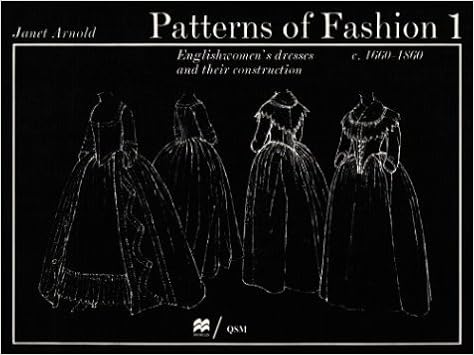In honor of Patterns of Fashion 5 being published by the The School of Historical Dress, I offer my belated reviews on the earlier volumes.
Patterns of Fashion 1: Englishwomen's Dresses and Their Construction c.1660-1860 by Janet Arnold
(revised edition, 1972)
I really, really like this series. As far as I can tell, Patterns of Fashion is the ur-example of a book based on measuring original historic dresses, and graphing out the component pieces (see also Corsets: Historical Patterns & Techniques, Regency Women's Dresses). And I really like that as a way of understanding the actual, historical methods for cutting and constructing of garments.
The bulk of the book is sketches of original dresses, with gridded patterns--most garments get a half-page of line drawings showing the garment as worn (front and back, some with additional detail sketches), and a page of 1/8 scale pattern pieces. There is also a good 18 pages worth of research and discussion on period dressmaking (including contemporary patterns, and depictions of dress-making), a one-page timeline of fashionable dress shapes, two pages of metric conversion information, and two pages of instructions for how to scale up the patterns.
I really appreciate that the pattern pieces are annotated to show connection points, trim lines, the location of pleats, fasteners, etc. Size and grain position are also given, which is a level of detail I rarely see in costuming books. The drawings are, in my opinion, very clear and detailed. The front cover gives a good idea of this, but I think the black-on-white of the interior pages is crisper and clearer than the white-on-black cover.
The book does give some suggestions for reproducing the garments, but if you are new to historic sewing, additional sources will be needed. The only historic sewing technique covered is cartridge pleating, which comes with instructions/illustrations at the end of the 'scaling up' section. The book list at the end does include recommendations for books on historic sewing. It is explicitly stated these are diagrams of real garments, made to fit specific people when worn in particular ways; and thus that reproducing them requires scaling the pattern, fitting it to the intended wearer, knowledge of sewing techniques, and proper undergarments.
The only other caveat I have is that the book has ~50 examples to cover a 200 year period, so if you are looking at only a narrow time frame, you may have few useful garments to choose from (but the information you do get is something you can't find in many other places). For instance, there was only one dress from c.1660, and one more c.1710 (a second dress from that decade appears in the additional notes); looking around 1750, however, has seven different garments including a gown, two jackets, a petticoat, two stomachers, and a pocket. The period 1730-1830 is particularly well-represented.
Stars: 5
Accuracy: High. All original garments, with the component pieces graphed out.
Difficulty: Advanced (for reproducing garments). All levels for appreciating garment construction.
Overall Impression: The Patterns of Fashion books are my holy grail for how dresses were historically cut and constructed. They are very useful for exploring how styles changed over time, and I'd recommend that every costumer or historian interested in western fashion read them. Or, at least, read the ones relevant to you time period. Even if there's only one or two garments from your particular year range, the cutting information is really interesting, and it's not something that easily found in other sources.

No comments:
Post a Comment
Thanks for commenting!